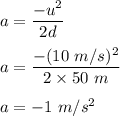
Physics, 07.03.2020 01:35 sanafarghal
A 2.0 kg block, initially moving at 10.0 m/s, slides 50.0 m across a sheet of ice beforecoming to rest. What is the magnitude of the average frictional force on the block?

Answers: 2


Other questions on the subject: Physics

Physics, 22.06.2019 02:50, NathalyN
An alligator swims to the left with a constant velocity of 5 \,\dfrac{\text{m}}{\text s}5 s m ? 5, space, start fraction, m, divided by, s, end fraction. when the alligator sees a bird straight ahead, the alligator speeds up with a constant acceleration of 3 \,\dfrac{\text {m}}{\text s^2}3 s 2 m ? 3, space, start fraction, m, divided by, s, start superscript, 2, end superscript, end fraction leftward until it reaches a final velocity of 35 \,\dfrac{\text {m}}{\text s}35 s m ? 35, space, start fraction, m, divided by, s, end fraction leftward. how many seconds does it take the alligator to speed up from 5 \,\dfrac{\text {m}}{\text s}5 s m ? 5, space, start fraction, m, divided by, s, end fraction to 35 \,\dfrac{\text {m}}{\text s}35 s m ? 35, space, start fraction, m, divided by, s, end fraction?
Answers: 3


Physics, 22.06.2019 15:30, haha81
Identify the correct relation showing that the radius r of the orbit of a moon of a given planet can be determined from the radius r of the planet, the acceleration of gravity at the surface of the planet, and the time τ required by the moon to complete one full revolution about the planet. determine the acceleration of gravity at the surface of the planet jupiter knowing that r = 71 492 km and that t= 3.551 days and r= 670.9 × 10^3 km for its moon europa.
Answers: 2

Physics, 22.06.2019 17:30, BabyG1353
Asilver dollar is dropped from the top of a building that is 1324 feet tall. use the position function below for free-falling objects. s(t) = −16t2 + v0t + s0 (a) determine the position and velocity functions for the coin. s(t) = v(t) = (b) determine the average velocity on the interval [1, 2]. ft/s (c) find the instantaneous velocities when t = 1 second and t = 2 seconds. v(1) = ft/s v(2) = ft/s (d) find the time required for the coin to reach the ground level. (round your answer to three decimal places.) t = s (e) find the velocity of the coin at impact. (round your answer to three decimal places.) ft/s
Answers: 3
You know the right answer?
A 2.0 kg block, initially moving at 10.0 m/s, slides 50.0 m across a sheet of ice beforecoming to re...
Questions in other subjects:

World Languages, 14.07.2019 10:00





Chemistry, 14.07.2019 10:00


History, 14.07.2019 10:00


History, 14.07.2019 10:00







